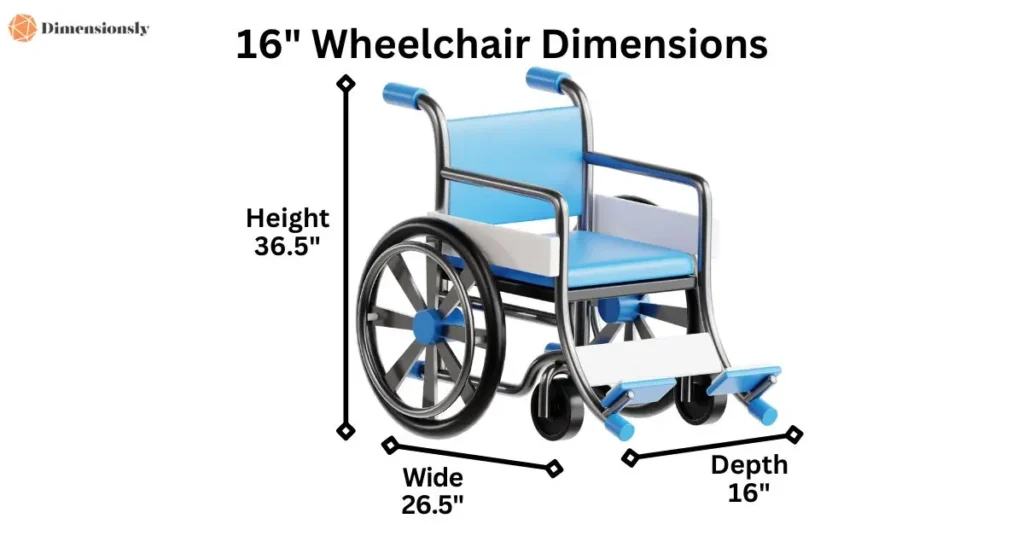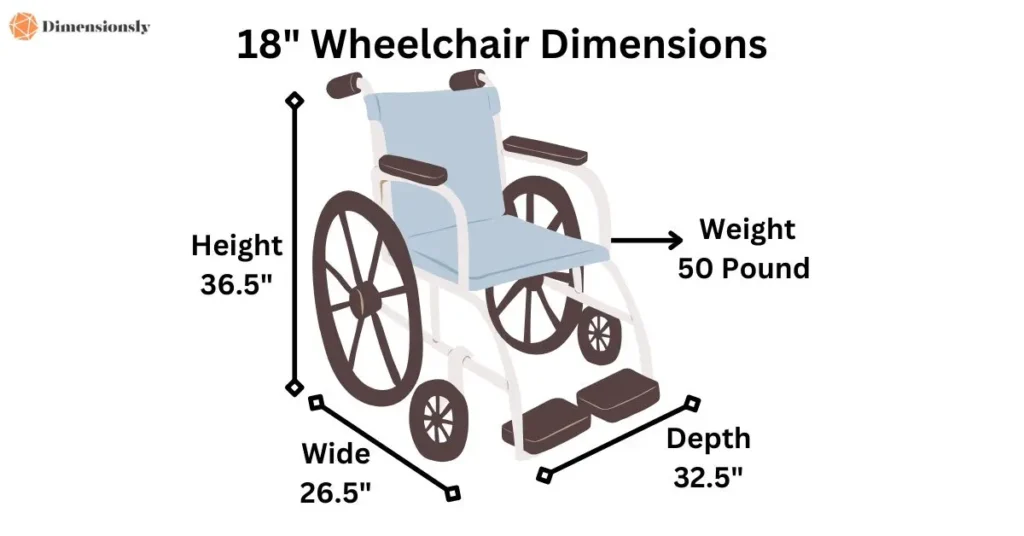Wheelchairs The 16″ wheelchair measures 16″D x 26.5″W x 36.5″H. The 18″ wheelchair has dimensions of 32.5″D x 26.5″W x 36.5″H, weighing 50 lbs. The 20″ wheelchair measures 36.5″D x 11.5″W x 32.5″H and weighs 52.2 lbs. These specifications ensure a perfect fit for your needs.
Wheelchair Dimensions
| 16″ Wheelchair Dimensions | 16″D x 26.5″W x 36.5″H |
| 15″ Wheelchair Dimensions | 32.5″D x 26.5″W x 36.5″H and 50 Pounds |
| 20″ Wheelchair Dimensions | 36.5″D x 11.5″W x 32.5″H and 50.2 Pounds |
Understanding Wheelchair Dimensions
Wheelchair dimensions include seat width, depth, height, and overall frame size—each affecting comfort and mobility. Choosing the right size involves tradeoffs; for example, a wider seat adds comfort but makes navigation harder, while a taller seat improves posture but complicates transfers.
A compact frame enhances maneuverability yet may reduce stability. Conversely, a larger frame offers better support but limits accessibility in tight spaces. Carefully balancing these factors ensures a wheelchair that maximizes both comfort and functionality.
Standard Wheelchair Seat Widths: 16″, 18″, and 20″
Selecting the right wheelchair seat width is essential for comfort, posture, and mobility. The most common widths—16″, 18″, and 20″—are designed to accommodate different body types, but each comes with tradeoffs.
A narrower seat enhances maneuverability but may feel restrictive, while a wider seat provides comfort yet can limit access through doorways. Understanding these differences ensures the best choice for individual needs.
16-Inch Wheelchair Dimensions and Best Use Cases
A 16-inch seat width is ideal for smaller individuals or those with a slim frame, offering a snug and supportive fit. This size enhances posture and prevents excessive shifting, making it easier to control the wheelchair.
However, a narrow seat may feel too tight for users who require extra cushioning or additional space for comfort. Balancing support with freedom of movement is key.

18-Inch Wheelchair Dimensions and Best Use Cases
An 18-inch seat width is the standard size for most users, providing a balance of comfort and accessibility. It fits through most doorways while offering enough space for support.
However, for users with broader frames or those who need additional padding, this size might be limiting. Choosing this width requires considering both ease of movement and individual body size.

20-Inch Wheelchair Dimensions and Best Use Cases
A 20-inch seat width offers extra space, improving comfort and weight distribution for larger individuals. While it reduces pressure points and enhances stability, its wider frame can make maneuvering in tight spaces challenging.
Additionally, it may not fit through standard doorways, requiring modifications to the environment. Users must weigh the benefits of comfort against potential mobility restrictions.

How to Measure for the Right Wheelchair Size
Accurately measuring your body and surroundings ensures a perfect wheelchair fit and enhances mobility. Start by measuring seat width, depth, and height, but balance comfort with maneuverability.
A wider seat adds comfort yet may limit access through doorways, while a narrower one improves mobility but can feel restrictive. Likewise, seat height affects posture but may complicate transfers. Carefully considering these factors helps achieve both comfort and functionality.
Key Measurements for Wheelchair Sizing
Selecting the right wheelchair size is essential for comfort, mobility, and overall well-being. Each measurement affects the user’s experience and must be carefully considered. Here’s how to determine the key dimensions and the trade-offs involved in each choice.
Seat Width
To measure seat width accurately, start by measuring the user’s hip width at the widest point while seated. For optimal comfort, add 1 to 2 inches of clearance to accommodate clothing and slight movement.
While a wider seat provides more room, it can also make maneuvering through doorways and tight spaces more difficult. Conversely, a narrow seat enhances mobility but may cause discomfort or pressure sores if too tight.
Seat Depth
Seat depth is measured from the back of the hip to the back of the knee while the user is seated. To ensure proper leg support, subtract approximately 1 to 2 inches from this measurement, preventing the seat from pressing into the back of the knees.
A deeper seat offers more thigh support but may restrict circulation, while a shallow seat can lead to discomfort and inadequate support.
Seat Height
Measure the distance from the user’s heel to the back of the knee. Be sure to factor in the thickness of the wheelchair cushion to maintain the correct height.
A higher seat may improve posture but can make foot propulsion harder for self-propelling users. A lower seat height aids foot propulsion but might create difficulties reaching tables or other surfaces.
Backrest Height
Backrest height should match the user’s needs. Measure from the seat to the desired level of back support. A low backrest allows greater upper-body movement, beneficial for active users, but may provide insufficient support.
A higher backrest enhances support and stability but can restrict arm movement, which is crucial for users who self-propel.
Armrest Height
To determine armrest height, measure from the seat to the elbow while the arm is bent at a 90-degree angle. Proper arm positioning helps prevent shoulder strain and enhances comfort.
High armrests support posture but can interfere with desk access, while low armrests offer more flexibility but may lead to discomfort over time.
Footrest Length
Footrest length is measured from the back of the knee to the bottom of the heel. Proper adjustment ensures feet rest comfortably on the footplate without excessive strain. Short footrests can elevate the knees, causing discomfort, while long footrests may lead to poor posture and inadequate support.
Balancing Trade-offs in Wheelchair Dimensions
Each measurement involves trade-offs. A wheelchair that is too wide or too narrow affects mobility and comfort. Seat height influences propulsion and accessibility, while backrest height impacts stability and freedom of movement. The challenge lies in striking a balance between support, mobility, and personal needs.
Ultimately, selecting the right wheelchair dimensions is about enhancing independence and ensuring daily comfort. Careful consideration of each measurement ensures a well-fitted wheelchair that supports both function and ease of use.
Factors to Consider When Choosing a Wheelchair
Choosing the right wheelchair involves more than just dimensions. Weight capacity affects durability but can add bulk. A lightweight frame improves portability yet may reduce stability. Larger wheels enhance outdoor mobility but make tight indoor navigation harder.
Smaller wheels improve maneuverability but require more effort on rough terrain. Balancing these factors ensures a wheelchair that meets both mobility needs and lifestyle demands while maximizing comfort and independence.
Conclusion
Choosing the right wheelchair size is crucial for both comfort and mobility. While a wider seat improves support, it may reduce maneuverability. A narrower seat enhances accessibility but can feel restrictive. Balancing these factors ensures a wheelchair that fits your lifestyle, maximizing independence while adapting to daily challenges and environments.
FAQs
1. How do I know which wheelchair seat width is right for me?
To determine the best seat width, measure the widest part of your hips or thighs while seated and add 1-2 inches for comfort. A 16-inch seat suits smaller users, 18-inch is standard for most, and 20-inch provides extra space for larger individuals.
2. Can a wheelchair that’s too wide or too narrow cause problems?
Yes, an overly wide wheelchair can reduce stability and make navigation difficult, especially through doorways. A too-narrow seat may cause discomfort, pressure sores, or restricted movement. Choosing the right balance ensures both comfort and mobility.
3. How does seat width affect maneuverability?
A narrower wheelchair is easier to maneuver through tight spaces and doorways but may feel restrictive. A wider wheelchair offers better support but can be harder to turn and fit in small areas. Consider your daily environment before selecting a size.
4. Do wheelchair dimensions include the wheels?
Not always. Seat width refers to the distance between armrests, while the overall wheelchair width (including wheels) is several inches wider. Check the total width to ensure it fits through doorways and narrow spaces.
5. What other factors should I consider besides seat width?
Frame type, weight capacity, seat depth, height, and wheel size all impact comfort and usability. A well-fitted wheelchair enhances independence, so balance these factors based on your body size, mobility needs, and daily environment.